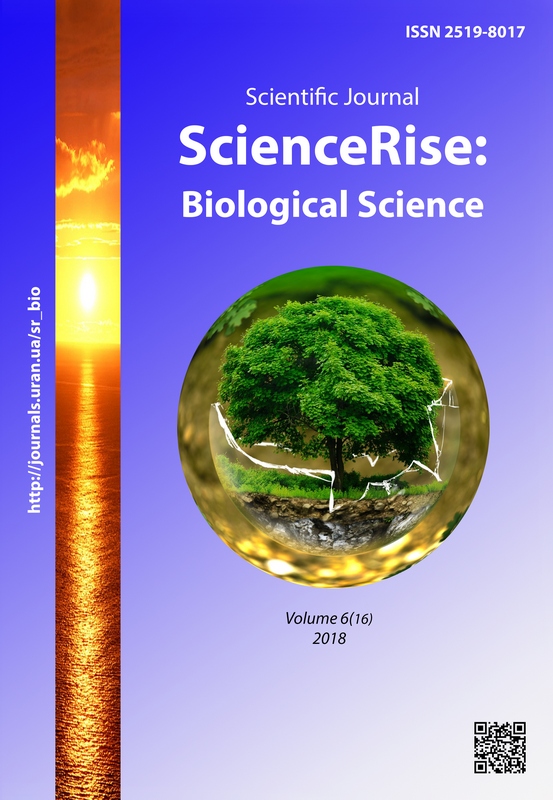Molecular genetic analysis of variability of HA, NA and NP genes of influenza virus А (compared to H1N1 and H7N9 strains)
DOI:
https://doi.org/10.15587/2519-8025.2018.153462Keywords:
Influenza virus A, H1N1, H7N9, gene variability, hemagglutinin, neurominidase, nucleoproteinAbstract
Due to the high antigenic variability and properties for reassortment of influenza A virus genes, analyze the variability of genetic markers of two different antigenic subtypes of influenza A virus strains H1N1 and H7N9 isolated from different hosts (humans and avian). The nucleotide sequences for analysis were taken from the database (NCBI). Using the MEGA6 cluster analysis program and calculating genetic distances using the ClustalW algorithm for the coding sequences of the nucleotides of the HA, NA and NP-protein genes, determinations were made on a sample of influenza strains A. Determination of single nucleotide substitutions at positions with mutations was performed using the Flusurver program. The construction of the dendrogram was carried out using the UPGM group pairwise clustering method, the reliability was calculated using the but-strep analysis. The variability of the neurominidase, hemagglutinin, and nucleoprotein genes was determined by local sequence alignment using the Smith – Waterman algorithm of the VectorNTI-11 program. Consensus sequences (СS) for HA, NA and NP-genes were formed; common conservative areas (motives) were found. The analysis of viral nucleic acids on the variability of the genetic markers of the avian influenza virus HA, NA and NP, coding the virulence factors in the H1N1 and H7N9 subtypes, showed genetic variability (variability) of the hemagglutinin and neurominidase genes.
A sample of gene sequences showed that the HA genes of the avian influenza virus have more interstitial polymorphism than the NA and NP protein genes. Genetic markers of high variability are the H1N1 subtype hemagglutinin genes and the NA genes in the H7N9 subtype. The article analyzes the structural features of the genes of surface proteins and nucleoproteins of influenza viruses AH1N1 and AH7N9. A certain degree of synonymity of nucleotide substitutions is determined. The relationship between the distribution of nucleotide polymorphism and indicators of synonymous and non-synonymous substitutions is established. The high variability of the NA gene, and somewhat less NA, determines the ability of the avian influenza virus, in particular its highly virulent strain H1N1 and less virulent H7N9, to overcome the interspecific barrier, whereas the replication factor encoded by the NP gene is less important for overcoming the interspecies barrier, which causes its low compared with ON and NA variability.
References
- Taubenberger, J. K., Kash, J. C. (2010). Influenza Virus Evolution, Host Adaptation, and Pandemic Formation. Cell Host & Microbe, 7 (6), 440–451. doi: https://doi.org/10.1016/j.chom.2010.05.009
- Ozawa, M., Kawaoka, Y. (2013). Cross Talk Between Animal and Human Influenza Viruses. Annual Review of Animal Biosciences, 1 (1), 21–42. doi: https://doi.org/10.1146/annurev-animal-031412-103733
- Webster, R. G., Bean, W. J., Gorman, O. T., Chambers, T. M., Kawaoka, Y. (1992). Evolution and ecology of influenza A viruses. Microbiol Rev., 56 (1), 152–179.
- Brockwell-Staats, C., Webster, R. G., Webby, R. J. (2009). Diversity of influenza viruses in swine and the emergence of a novel human pandemic influenza A (H1N1). Influenza and Other Respiratory Viruses, 3 (5), 207–213. doi: https://doi.org/10.1111/j.1750-2659.2009.00096.x
- Allison, A. B., Ballard, J. R., Tesh, R. B., Brown, J. D., Ruder, M. G., Keel, M. K. et. al. (2014). Cyclic Avian Mass Mortality in the Northeastern United States Is Associated with a Novel Orthomyxovirus. Journal of Virology, 89 (2), 1389–1403. doi: https://doi.org/10.1128/jvi.02019-14
- Dukhovlinov, I., Al-Shekhadat, R., Fedorova, E., Stepanova, L., Potapchuk, M., Repko, I. et. al. (2013). Study of immunogenicity of recombinant proteins based on hemagglutinin and neuraminidase conservative epitopes of Influenza A virus. Medical Science Monitor Basic Research, 19, 221–227. doi: https://doi.org/10.12659/msmbr.884002
- Wu, C.-Y., Lin, C.-W., Tsai, T.-I., Lee, C.-C. D., Chuang, H.-Y., Chen, J.-B. et. al. (2016). Influenza A surface glycosylation and vaccine design. Proceedings of the National Academy of Sciences, 114 (2), 280–285. doi: https://doi.org/10.1073/pnas.1617174114
- Tada, T., Suzuki, K., Sakurai, Y., Kubo, M., Okada, H., Itoh, T., Tsukamoto, K. (2011). Emergence of Avian Influenza Viruses with Enhanced Transcription Activity by a Single Amino Acid Substitution in the Nucleoprotein during Replication in Chicken Brains. Journal of Virology, 85 (19), 10354–10363. doi: https://doi.org/10.1128/jvi.00605-11
- Sha, B., Luo, M. (1997). Structure of a bifunctional membrane-RNA binding protein, influenza virus matrix protein M1. Nature Structural Biology, 4 (3), 239–244. doi: https://doi.org/10.1038/nsb0397-239
- Tamura, K., Peterson, D., Peterson, N., Stecher, G., Nei, M., Kumar, S. (2011). MEGA5: Molecular Evolutionary Genetics Analysis Using Maximum Likelihood, Evolutionary Distance, and Maximum Parsimony Methods. Molecular Biology and Evolution, 28 (10), 2731–2739. doi: https://doi.org/10.1093/molbev/msr121
- Efron, B. (1979). Bootstrap Methods: Another Look at the Jackknife. The Annals of Statistics, 7 (1), 1–26. doi: https://doi.org/10.1214/aos/1176344552
- Smith, T. F., Waterman, M. S. (1981). Identification of common molecular subsequences. Journal of Molecular Biology, 147 (1), 195–197. doi: https://doi.org/10.1016/0022-2836(81)90087-5
Downloads
Published
How to Cite
Issue
Section
License
Copyright (c) 2018 Semen Buriachenko

This work is licensed under a Creative Commons Attribution 4.0 International License.
Our journal abides by the Creative Commons CC BY copyright rights and permissions for open access journals.
Authors, who are published in this journal, agree to the following conditions:
1. The authors reserve the right to authorship of the work and pass the first publication right of this work to the journal under the terms of a Creative Commons CC BY, which allows others to freely distribute the published research with the obligatory reference to the authors of the original work and the first publication of the work in this journal.
2. The authors have the right to conclude separate supplement agreements that relate to non-exclusive work distribution in the form in which it has been published by the journal (for example, to upload the work to the online storage of the journal or publish it as part of a monograph), provided that the reference to the first publication of the work in this journal is included.









